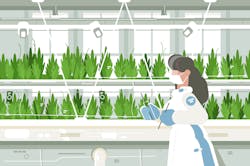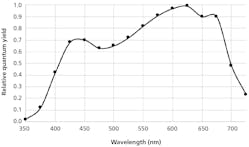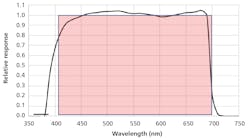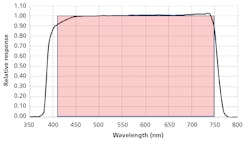If you are familiar with horticultural lighting, you likely know about PAR (photosynthetically active radiation), which is used to characterize horticultural luminaire efficacy. However, you may not know about the related metric ePAR, or extended PAR. Like PAR, ePAR is used to characterize luminaire efficacy, but whether it meets the general requirements to be labeled a metric remains for debate.
ANSI/ASABE S640 defines PAR as “the spectral range (waveband) of radiation, from 400 nm to 700 nm, which by definition photosynthetic organisms are able to use in the process of photosynthesis.” PAR can be measured as either photosynthetic photon flux (PPF) or photosynthetic photon flux density (PPFD). PAR — also known as quantum meters — measure PPFD, but PPF is the appropriate measure for determining horticultural luminaire efficacy. It is defined as “the rate of flow of photons within the PAR waveband from a radiation source,” measured in micromoles of photons per second (µmol × sec-1).
From this, we can define photosynthetic photon efficacy (PPE) as “the photosynthetic photon flux divided by input electric power,” which is expressed in micromoles per second per electrical watt (µmol × sec-1 × We-1), or equivalently micromoles per joule (µmol × J-1). Typical values for horticultural luminaires are 1.9 µmol × J-1 for high-pressure sodium lamps and 2.0 µmol × J-1 or greater for LED modules.
The definition of ePAR is identical except that the waveband is defined as 400 nm to 750 nm. This expanded spectral range is based on fascinating research that began more than 65 years ago.
Emerson enhancement effect
In 1957, Robert Emerson measured the photosynthetic rate of green algae (Chlorella pyrenoidosis) exposed to deep-red light with wavelengths longer than approximately 685 nm. As expected, the rate was very low. However, when he exposed the algae to supplemental red light with wavelengths less than 685 nm, there was a marked increase. The resultant photosynthetic rate was greater than that of the sum of the two wavelengths alone; this became known as the Emerson enhancement effect.
The experimental results only suggested that the photosynthetic efficiency of longer-wavelength photons (approximately 680 nm to 720 nm) could be improved with shorter-wavelength supplemental light, which had little practical use. Still, the results demonstrated the first evidence of the two photosystems — PSI and PSII — responsible for the photosynthetic process.
Emerson revisited
Zhen and van Iersel (2017) extended Emerson’s work by exposing lettuce (Lactuca sativa) to red-blue or warm-white light in combination with 735-nm far-red light. They found that far-red light increased the photosynthetic rate under red-blue light or warm-white light, due to the synergetic interactions between PSI and PSII.
Zhen and Bugbee (2020) extended this study, finding that lettuce grown under red-blue light with supplemental far-red light (up to 40%) increased biomass of shoot and root by 29% to 31%, and leaf area by 36% to 43%. These commercially significant results indicate the utility of supplemental far-red light in horticultural lighting.
Here we arrive at the question of metrics: How do you quantify PPF for both PAR (400–700 nm) and ePAR (400–750 nm) in order to determine PPE for horticultural luminaires?
Defining PAR and ePAR
McCree (1972) measured the photosynthetic rate of 22 crop species when exposed to narrow (~25-nm) spectral bands of light from 350 nm to 725 nm under both laboratory and field conditions. Results did not vary significantly between the assorted species under field conditions, so McCree used their average on a per-wavelength basis to define the McCree curve shown in Fig. 1.
PAR sensors are not spectrally calibrated to the McCree curve because the curve is based on single-leaf measurements under low light-level conditions. Further studies employing more modern and sensitive equipment, as well as more realistic growing conditions, have produced different results.
The PAR metric is therefore defined in terms of the Stark-Einstein law: One absorbed photon, regardless of its wavelength (hence energy), results in one photochemical reaction over the PAR spectral range for photosynthetic organisms. Figure 2 shows the spectral response of a commercial PAR sensor based on this definition.
Figure 3 shows the spectral response of a commercial ePAR sensor based on the spectral range of 400 nm to 750 nm.
Controversy over photosynthetic efficacy metrics
In its 2021 white paper “Limitations of Predicting Far-Red’s Effect on Photosynthesis,” the DesignLights Consortium (DLC) notes that only PAR wavelengths are considered in its calculation of PPE for satisfying the minimum requirements for its Horticultural Qualified Products List (QPL). This method penalizes luminaires with far-red LEDs, as the electrical power required for these LEDs reduces the PPE.
Zhen et al. (2021) published a rebuttal to the DLC arguments in Frontiers in Plant Science: “Why Far-Red Photons Should Be Included in the Definition of Photosynthetic Photons and the Measurement of Horticultural Fixture Efficacy.”
The DLC argued that the synergistic effect of far-red photons depends on the spectral power distribution (SPD) of the supplemental PAR photons, noting that, according to research conducted by Zhen et al., the measured photosynthetic rate differed between red-blue and warm-white LEDs. Zhen et al. countered that this was incorrect, as the warm-white LEDs already produced 4% far-red photons. These photons skewed the results for warm-white LEDs.
The DLC, again based on research conducted by Zhen et al., further argued that the Emerson enhancement effect was dependent on the light level. The PAR metric assumes a linear response. If the Emerson enhancement effect is dependent on the light level, it has a nonlinear response and so does not qualify as a metric. Zhen et al. responded that their research had been misinterpreted, and that the Emerson enhancement effect is linear. Summarizing their response, the authors noted that “when added to a background of 400 – 700 nm photons, far-red photons increased photosynthesis equal to the addition of traditional PAR photons.”
Finally, the DLC argued that the Emerson enhancement effect was dependent on peak wavelength and SPD of the far-red LEDs. Zhen et al. countered that this was due to the spectral bandwidth of the LEDs used in their research, with 711-nm LEDs emitting 29% of their photons in the PAR region, and 746-nm LEDs emitting 24% of their photons beyond 750 nm.
In doing so, Zhen et al. made a significant point: “It is well-known that photons of different wavelengths within the 400 – 700 nm range elicit different photosynthetic responses.” This is clear from the McCree curve (Fig. 1). By assuming that the Stark-Einstein law applies with all PAR photons being considered equal, the PAR metric is a convenient fiction, and the ePAR metric is no different — despite their utility in some cases.
Phytochrome and R:FR
Zhen et al. would appear to have successfully argued the case for the DLC adopting ePAR as its metric for calculating PPE. However, we still need to address a key plant morphological response to light.
In addition to chlorophyll A/B and their accessory photoreceptors, such as beta-carotene, plants contain phytochrome, a photo-reversible pigment with two isoforms: Pr and Pfr. When Pr senses red light with a peak around 660 nm, it changes into Pfr. When Pfr senses far-red light with a peak around 735 nm, it reverts to Pr. This is useful because typical green leaves transmit only about 4% of red light at 660 nm, but they transmit about 50% of far-red light at 735 nm.
The ratio of phytochrome Pr to Pfr is therefore determined by the ratio of red light (600–700 nm) to far-red light (referred to as the R:FR ratio), which enables the plant to determine whether it is being shaded by its neighbors. The R:FR ratio of direct sunlight on a clear day is about 1.3, but a single layer of leaves will reduce this to 0.2 or less. Each additional layer of leaves will further reduce the ratio.
If a plant determines that it is being shaded, it will inhibit its lateral growth while elongating its stems, leaves, and petioles to tower above the competition. In doing so, the plant necessarily diverts resources from other priorities, including producing secondary metabolites for pathogen resistance and insect herbivore deterrence, improving drought tolerance, and reducing root biomass. Together, these responses are called the shade-avoidance syndrome (SAS). They may be muted or absent in shade-loving plants.
Alternatively, if the R:FR ratio is too high, the plant may instead grow in a compact form and flower early in order to produce seeds and survive into the next generation, while leaving its neighbors more susceptible to windborne pathogens and herbivore predation.
The R:FR ratio also controls flowering in plants that are sensitive to day length, especially “long-day” plants. The flowering of some ornamental plants, such as petunias and pansies, can be delayed by using light sources with high R:FR ratios and advanced with low R:FR ratios.
The point is that the R:FR ratio can affect plant growth and development (morphology), secondary metabolite production, and flowering times. Horticulturalists tailor the R:FR ratio to achieve desirable results. Notably, the responses can be both species and cultivar-specific, requiring considerable experimentation to achieve optimal results.
PAR or ePAR?
If we consider photosynthesis alone, the ePAR metric makes sense for evaluating luminaire efficacy. However, far-red light elicits plant responses such as SAS, and it may have species- and cultivar-specific effects on plant flowering. If the ePAR metric alone is considered, we cannot predict these responses because the R:FR ratio is unknown.
The DLC currently considers only PAR for its determination of luminaire PPE and approval for its Horticultural QPL. The DLC allows luminaire manufacturers to report far-red light within the wavelength range from 700 nm to 800 nm, but this information is not used for qualification purposes. Luminaire manufacturers who submit products with far-red LEDs are therefore penalized, as the electrical power needed for these LEDs is not taken into consideration.
The DLC could create a separate category for luminaires with far-red LEDs wherein the ePAR metric is used for PPE calculations. Still, the responses of plants to far-red light (apart from photosynthesis) vary greatly between species and cultivars. As such, a luminaire with a fixed portion of far-red light may have a limited market. If a grower tries such a luminaire and finds that the SAS responses or flowering times produce undesirable results, they will likely not recommend it to their colleagues.
Perhaps the best solution is for manufacturers to equip luminaires with far-red LEDs with a switch or jumper that enables or disables them as required. With the LEDs disabled, the DLC can measure the PAR output and fairly calculate the PPE, while growers can experiment with various crops with and without far-red lighting.
Conclusion
We have established that ePAR qualifies as a proper metric and can be used as an alternative to PAR for characterizing the photosynthetic photon efficacy. However, far-red light can result in unexpected responses, including undesirable plant growth and development and changes in flowering time. The ePAR metric by itself does not indicate the R:FR ratio, so its use as an industry-standard metric for photosynthesis remains problematic.
REFERENCES
DesignLights Consortium (DLC), “Limitations of Predicting Far-Red’s Effect on Photosynthesis” (2021; Accessed March 12, 2023).
R. Emerson et al., “Some Factors Influencing the Long-Wave Limit of Photosynthesis,” Botany, 43, 1 (1957).
K.J. McCree, “The Action Spectrum, Absorptance and Quantum Yield of Photosynthesis in Crop Plants,” Agricultural Meteorology, 9, 191–216 (1972).
S. Zhen and M.W. van Iersel, “Far-red Light is Needed for Efficient Photochemistry and Photosynthesis,” J. Plant Physiology (2017).
S. Zhen and B. Bugbee, “Substituting Far-red for Traditionally Defined Photosynthetic Photons Results in Equal Canopy Quantum Yield for CO2 Fixation and Increased Photon Capture During Long-Term Studies: Implications for Re-defining PAR,” Frontiers in Plant Science (2020).
S. Zhen, M.W. van Iersel, and B. Bugbee, “Why Far-Red Photons Should Be Included in the Definition of Photosynthetic Photons and the Measurement of Horticultural Fixture Efficacy,” Frontiers in Plant Science (2021).
IAN ASHDOWN, P. Eng. (Ret.), FIES, is senior scientist and president of SunTracker Technologies based in Victoria, British Columbia.
Follow our LinkedIn page for our latest news updates, contributed articles, and commentary, and our Facebook page for events announcements and more. You can also find us on Twitter.









